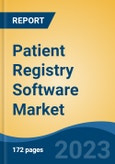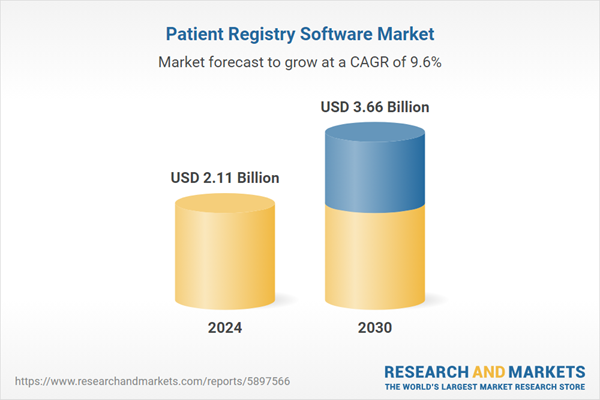Free Webex Call
The Patient Registry Software Market was valued at USD 2.11 Billion in 2024, and is expected to reach USD 3.66 Billion by 2030, rising at a CAGR of 9.57%. Patient Registry Software is a specialized healthcare technology solution designed to collect, manage, and analyze comprehensive and structured data about patients with specific medical conditions, diseases, or characteristics. It serves as a centralized database for healthcare organizations, research institutions, and public health agencies to maintain detailed records of patients' medical histories, treatment outcomes, and other relevant information. Patient registries are often disease-specific, meaning they are tailored to gather data on patients with medical conditions. Speak directly to the analyst to clarify any post sales queries you may have.
10% Free customizationThis report comes with 10% free customization, enabling you to add data that meets your specific business needs.
These conditions can range from common chronic diseases like diabetes or cardiovascular disorders to rare diseases or specific patient characteristics (e.g., pregnancy registries). To ensure consistency and interoperability, patient registry software often adheres to standardized data formats, coding systems (e.g., ICD-10, SNOMED CT), and medical terminology. Standardization is critical for data exchange and analysis. The software includes validation rules and checks to ensure that data entered the registry is accurate and adheres to predefined standards. Validation helps maintain data quality and reliability.
Key Market Drivers
Growing Epidemiological Studies
Epidemiological studies aim to understand the distribution and determinants of diseases within populations. Patient registry software is instrumental in these studies, offering structured and efficient data collection, storage, and management from diverse sources such as healthcare facilities, research institutions, and public health agencies. This systematic data collection is vital for large-scale epidemiological research.Continuous monitoring of diseases is essential in epidemiology. Patient registry software facilitates real-time data capture and surveillance, enabling the identification of disease trends, outbreaks, and patterns. For instance, the OpenSAFELY platform in the UK has been pivotal in analyzing risk factors associated with COVID-19, utilizing data from approximately 58 million patients. Such platforms underscore the significance of patient registries in real-time health data analysis.
Key Market Challenges
Data Quality and Accuracy
Ensuring the reliability and precision of data within patient registries is crucial for their effectiveness in supporting healthcare research, clinical care, and public health initiatives. Human errors during data entry, such as typos or incorrect information, can lead to inaccuracies in patient records. Even minor mistakes can have significant implications for patient care and research. Missing or incomplete data fields within patient records can hinder the ability to derive meaningful insights from the registry. Incomplete data may result from oversight during data entry or limitations in data collection processes. Duplicate records for the same patient can distort statistics and analysis.Patient registry software should have mechanisms to detect and prevent duplicate entries. Inconsistencies in data format, terminology, or coding can make it challenging to perform accurate analyses and comparisons. Standardizing data entry and terminology is crucial for consistency. Ensuring that data entered the registry is valid and follows predefined rules and standards is essential. Without proper validation, inaccurate data may be included. Maintaining data security and privacy while ensuring data quality is a delicate balance. Stringent security measures may restrict data accessibility, potentially affecting data accuracy. The absence of clear data governance policies and procedures can lead to data quality issues. Establishing data governance frameworks helps maintain data accuracy and consistency.
Key Market Trends
Increased Adoption of Cloud-Based Solutions
Cloud-based patient registry software can easily scale up or down based on the needs of healthcare organizations. This flexibility is crucial as patient data volumes can vary significantly. Cloud solutions often eliminate the need for extensive on-premises hardware and infrastructure, reducing capital expenditures. Healthcare organizations can pay for cloud services on a subscription or pay-as-you-go basis, aligning costs with actual usage. Cloud-based patient registry software allows authorized users to access patient data and registry functions from virtually anywhere with an internet connection. This is particularly valuable for remote healthcare settings and telehealth initiatives.Reputable cloud providers invest heavily in security measures, often exceeding what individual healthcare organizations can implement. These providers offer robust data encryption, access controls, and disaster recovery options to protect patient data. Cloud-based solutions typically offer automated data backup and recovery capabilities, reducing the risk of data loss due to hardware failures or disasters. Cloud-based patient registry software can facilitate data sharing and interoperability by providing standardized interfaces and APIs. This enables integration with other healthcare systems, including EHRs and laboratory systems. Cloud vendors provide ongoing support, updates, and maintenance for the software, reducing the burden on healthcare IT staff.
Key Market Players
- Dacima Software Inc.
- FIGmd Inc.
- Global Vision Technologies Inc.
- Image Trend Inc.
- IQVIA
- Ordinal Data, Inc.
- McKensson Corporation
- Syneos Health
- Velos Inc.
- Cerner Corporation
Report Scope:
In this report, the Global Patient Registry Software Market has been segmented into the following categories, in addition to the industry trends which have also been detailed below:Patient Registry Software Market, By Type of Registry:
- Disease Registries
- Health Service Registries
- Product Registries
Patient Registry Software Market, By Type of Software:
- Stand-alone Software
- Integrated Software
Patient Registry Software Market, By End User:
- Hospitals
- Government Organizations and Third-Party Administrators (TPAs)
- Pharmaceutical, Biotechnology, and Medical Device Companies
- Other
Patient Registry Software Market, By region:
- North America
- United States
- Canada
- Mexico
- Asia-Pacific
- China
- India
- South Korea
- Australia
- Japan
- Europe
- Germany
- France
- United Kingdom
- Spain
- Italy
- South America
- Brazil
- Argentina
- Colombia
- Middle East & Africa
- South Africa
- Saudi Arabia
- UAE
Competitive Landscape
Company Profiles: Detailed analysis of the major companies present in the Global Patient Registry Software Market.Available Customizations:
With the given market data, the publisher offers customizations according to a company's specific needs. The following customization options are available for the report.Company Information
- Detailed analysis and profiling of additional market players (up to five).
This product will be delivered within 1-3 business days.
Table of Contents
1. Product Overview
2. Research Methodology
3. Executive Summary
5. Global Patient Registry Software Market Outlook
6. Asia Pacific Patient Registry Software Market Outlook
7. Europe Patient Registry Software Market Outlook
8. North America Patient Registry Software Market Outlook
9. South America Patient Registry Software Market Outlook
10. Middle East and Africa Patient Registry Software Market Outlook
11. Market Dynamics
12. Market Trends & Developments
14. Porter’s Five Forces Analysis
16. Competitive Landscape
Companies Mentioned
- Dacima Software Inc.
- FIGmd Inc.
- Global Vision Technologies Inc.
- Image Trend Inc.
- IQVIA
- Ordinal Data, Inc.
- McKensson Corporation
- Syneos Health
- Velos Inc.
- Cerner Corporation
Table Information
| Report Attribute | Details |
|---|---|
| No. of Pages | 182 |
| Published | April 2025 |
| Forecast Period | 2024 - 2030 |
| Estimated Market Value ( USD | $ 2.11 Billion |
| Forecasted Market Value ( USD | $ 3.66 Billion |
| Compound Annual Growth Rate | 9.5% |
| Regions Covered | Global |
| No. of Companies Mentioned | 10 |









